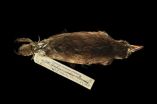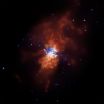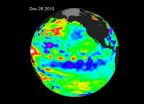In this release:
Spooky action at a distance, for earthquakes Evidence for water ice near the Martian equator Extraordinary uplift of Yellowstone caldera New evidence could let supereruption off the hook Auroral oscillations seen on Saturn How much sea-level rise can coastal marshes withstand? Rain affects carbon-dioxide flow between sky and sea Ionosphere model overshoots during solar minimum
Anyone may read the scientific abstract for any already-published paper by clicking on the link provided at the end of each Highlight. You can also read the abstract by going to http://www.agu.org/pubs/search_options.shtml and inserting into the search engine the full doi (digital object identifier), e.g. 10.1029/2010GL045181. The doi is found at the end of each Highlight below.
Journalists and public information officers (PIOs) at educational or scientific institutions, who are registered with AGU, also may download papers cited in this release by clicking on the links below. Instructions for members of the news media, PIOs, and the public for downloading or ordering the full text of any research paper summarized below are available at http://www.agu.org/news/press/papers.shtml.
1. Spooky action at a distance, for earthquakes
On 27 February 2010, a magnitude 8.8 earthquake rocked millions of Chileans from their slumber, but the South American people weren't the only ones so affected. New research by Peng et al. suggests that the trembling off the Chilean coast could have triggered a swarm of shallow earthquakes nearly 10,000 km away in central California.
The team identifies four earthquakes with magnitudes of 2 or higher, with the largest of the group being a M 3.5 quake that rattled the Coso geothermal field. The affected region is plagued by small earthquakes, but when the authors calculated the chance of a swarm so neatly following the Chilean earthquake, they inferred that the two seismic events were probably connected.
The authors also see a cluster of deep, low-frequency earthquakes along the Parkfield-Cholame section of the San Andreas Fault, which also appeared to be influenced by the Chilean event. The researchers suggest that the timing of the California earthquakes was affected by the arrival of Love waves—horizontal surface movement that would have traveled out from the epicenter of the Chilean earthquake, pushing already stressed faults over the edge.
Title: Remotely triggered microearthquakes and tremor in Central California following the 2010 Mw 8.8 Chile Earthquake
Authors: Zhigang Peng, Chastity Aiken: School of Earth and Atmospheric Sciences, Georgia Institute of Technology, Atlanta, Georgia, USA;
David P. Hill, David R. Shelly: United States Geological Survey, Menlo Park, California, USA.
Source: Geophysical Research Letters, doi:10.1029/2010GL045462, 2010
http://dx.doi.org/10.1029/2010GL045462
2. Evidence for water ice near the Martian equator
When one looks for water on Mars, the most obvious targets are the ice-capped polar regions. However, Shean finds what appears to be buried water ice or an ice-debris mix within 38 craters in the Sinus Sabaeus region near the Martian equator. While previous research has suggested that water was historically present near the equator, Mars's current climate is supposed to be inhospitable to equatorial water ice. Using satellite imagery, the author finds material at the bottom of equatorial craters that is visually similar to material thought to be buried ice found elsewhere on Mars, especially in midlatitude craters (30°to 60°N/S). He also finds 30 additional craters where this material has been partially or completely removed, leaving traces that suggest it is composed of buried ice.
The findings corroborate the idea that Mars experiences dramatic climate change when the planet's axial tilt shifts. Earth's axial tilt undergoes small wobbles but tends to stay within a few degrees of its current position of 23.4°. Mars's tilt, which currently sits at 25.2°, is thought to oscillate between about 0° and 60°. General circulation models of the red planet's atmosphere suggest that the Sinus Sabaeus region would see increases in ice stability and preferential increases in water ice precipitation when the axial tilt exceeds 35°to 40°. This configuration has occurred multiple times in the past 10 million years, and the ice has apparently survived in the modern Martian climate due to its burial under debris or other low-permeability material.
Title: Candidate ice-rich material within equatorial craters on Mars
Authors: David E. Shean: Malin Space Science Systems, San Diego, California, USA.
Source: Geophysical Research Letters, doi:10.1029/2010GL045181, 2010
http://dx.doi.org/10.1029/2010GL045181
3. Extraordinary uplift of Yellowstone caldera
Beginning in 2004, the Yellowstone caldera, extending 40 kilometers by 60 km (25 miles by 37 miles) in Yellowstone National Park, northwestern Wyoming, began a period of accelerated uplift, with rates of uplift as high as 7 centimeters per year, or 2.8 inches per year. From 2006 to 2009 the uplift rate slowed.
Global Positioning System (GPS) and interferometric synthetic aperture radar (InSAR) ground deformation measurements described by Chang et al. show that in the northern caldera uplift decreased from 7 cm/yr in 2006 to 5 cm/yr in 2008 and 2 cm/yr in 2009. In the southwestern portion of the caldera, uplift decreased from 4 cm/yr in 2006 to 2 cm/yr in 2008 and 0.5 cm/yr in 2009, demonstrating a spatial pattern of ground motion decrease from southwest to northeast along the caldera.
What caused this extraordinary uplift, and why has the uplift slowed? On the basis of models the authors suggest that the uplift since mid-2004 was caused primarily by a growing magma reservoir 7 to 10 km (4 to 6 mi) below the caldera. The magma reservoir has been expanding, but the expansion rate decreased 60 percent between 2006 and 2009. The slowing expansion of the magma reservoir, along with release of stress by extensive earthquakes that occurred in clusters, called swarms, in 2008 and 2010, can account for the slowing uplift, the researchers suggest. Continued monitoring of ground deformation in the Yellowstone caldera could be useful for understanding volcanic physics and the related volcano and earthquake hazard in the region.
Title: An extraordinary episode of Yellowstone caldera uplift, 2004 to 2010, from GPS and InSAR observations
Authors: Wu-Lung Chang: Department of Earth Sciences, National Central University, Jhongli, Taiwan;
Robert B. Smith, Jamie Farrell, and Christine M. Puskas: Department of Geology and Geophysics, University of Utah,Salt Lake City, Utah, USA
Source: Geophysical Research Letters, doi:10.1029/2010GL045451, 2010
http://dx.doi.org/10.1029/2010GL045451
4. New evidence could let supereruption off the hook
It's a case of forensic analysis on the grandest scale: the possible near-extinction of the entire human race at the hands of one volcanic supereruption. The Younger Toba Tuff (YTT) eruption 74,000 years ago was accused of blanketing the sky with sulfate aerosols and driving the world into permanent winter. In a new study, Timmreck et al. have given the Sumatran volcano a climatological alibi. The authors use a global circulation model to simulate the YTT eruption, including for the first time an analysis of the small-scale interactions between sulfate particles. Sulfate particles in the upper atmosphere strongly reflect incoming solar radiation, which has a cooling effect on the Earth.
The researchers find that sulfate particles would clump together, reaching their maximum size and settling out of the atmosphere after only 4 years. The authors found that the YTT eruption could be held responsible for only a maximum reduction of 3.5 degrees Celsius in global average temperature and a significant cooling of less than a decade, rather than the decade- or century-long double-digit drops of which it had been accused. With the cooling too small and the duration too short, the results raise questions about the volcanic influence on a possible human population bottleneck at this time.
Title: Aerosol size confined climate response to volcanic super-eruptions
Authors: Claudia Timmreck: Max-Planck Institute for Meteorology, Hamburg, Germany;
Hans-F. Graf: Centre Atmospheric Science, University of Cambridge, Cambridge, UK;
Stephan J. Lorenz, Ulrike Niemeier, Davide Zanchettin, Daniela Matei, and Johann H. Jungclaus: Max-Planck Institute for Meteorology, Hamburg, Germany;
Thomas J. Crowley: School of GeoSciences, University of Edinburgh, Edinburgh, UK.
Source: Geophysical Research Letters, doi:10.1029/2010GL045464, 2010
http://dx.doi.org/10.1029/2010GL045464
5. Auroral oscillations seen on Saturn
Using images from the Hubble Space Telescope, Nichols et al. observe oscillations in the locations of Saturn's northern and southern auroral ovals. Both auroral ovals' positions oscillate 1°to 2° between dawn and dusk. While the southern auroral oval oscillation had been previously observed, the present observation, made during Saturn's 2009 equinox, is the first one that indicates that the location of the northern auroral oval oscillates with similar amplitude.
The researchers also find that the locations of the auroral ovals oscillate with periods close to the rotation periods of radio emissions known as Saturn kilometric radiation (SKR).
In a related paper, Gurnett et al. (Geophys. Res. Lett., 37, L24101, doi:10.1029/2010GL045796 http://dx.doi.org/10.1029/2010GL045796) observe changes in the rotational modulation rate of the SKR that could be controlled by changes in the planet's magnetosphere. Magnetosphere effects could cause shifting of the auroral ovals as well.
Title: Dawn-dusk oscillation of Saturn's conjugate auroral ovals
Authors: J. D. Nichols: Department of Physics and Astronomy, University of Leicester, Leicester, UK
S. W. H. Cowley: Department of Physics and Astronomy, University of Leicester, Leicester, UK
L. Lamy: LESIA, Observatoire de Paris, Meudon, France
Source: Geophysical Research Letters, doi:10.1029/2010GL045818, 2010
http://dx.doi.org/10.1029/2010GL045818
6. How much sea-level rise can coastal marshes withstand?
As sea level rises, many coastal marshes worldwide are predicted to submerge. What is the maximum rate of sea level rise that a coastal marsh can survive? Many previous studies of this question have assumed that the coastal wetland landscape is static, but in fact, many coastal wetlands can adapt to sea level changes. For instance, in tidal marshes, increasing inundation leads to higher rates of sediment deposition, raising the elevation of the wetland and helping it withstand sea level rise. In salt marshes, higher sea levels can lead to increased growth of vegetation, which traps sediment and limits erosion.
To determine the critical rates of sea level rise that coastal wetlands can withstand, Kirwan et al. use five models that consider the ways that wetlands adapt. They find that coastal marshes with low suspended sediment concentration and low tidal range (the difference between high and low tides) would be submerged at rates of sea level rise of only a few millimeters per year (about 0.1 inch), while marshes with high suspended sediment concentration (greater than about 20 milligrams per liter) and high tidal ranges could survive sea level rise rates of more than a centimeter (0.4 inch) per year.
On the basis of their models the researchers predict that in the near future, several large marshes, including Plum Island Estuary in Massachusetts and marshes in the Albemarle-Pamlico Sound in North Carolina, are likely to submerge. Over the next century, if global warming and sea level rise follow conservative projections, many marshes worldwide will survive, but if warming is more rapid and sea level rises by more than a centimeter per year, most marshes worldwide will be lost.
See 12/1/2010 press release at:
http://www.agu.org/news/press/pr_archives/2010/2010-41.shtml
Title: Limits on the adaptability of coastal marshes to rising sea level
Authors: Matthew L. Kirwan: Patuxent Wildlife Research Center, U.S. Geological Survey, Laurel, Maryland, USA; and Department of Environmental Science, University of Virginia, Charlottesville, Virginia, USA;
Glenn R. Guntenspergen: Patuxent Wildlife Research Center, U.S. Geological Survey, Laurel, Maryland, USA;
Andrea D'Alpaos: Dipartimento di Geoscienze, Universita di Padova, Padua, Italy;
James T. Morris: Belle W. Baruch Institute for Marine and Coastal Sciences, University of South Carolina, Columbia, South Carolina, USA;
Simon M. Mudd: School of GeoSciences, University of Edinburgh, Edinburgh, UK;
Stijn Temmerman: Department of Biology, University of Antwerpen, Wilrijk, Belgium.
Source: Geophysical Research Letters, doi:10.1029/2010GL045489, 2010
http://dx.doi.org/10.1029/2010GL045489
7. Rain affects carbon-dioxide flow between sky and sea
Exchanges of carbon dioxide (CO2) between the atmosphere and the oceans play an important role in the global carbon cycle and in determining how much CO2 is stored in the atmosphere and how much is stored in the ocean. A new study shows that rain can be an important, though often overlooked, factor in this exchange.
Rain can contribute to the air-sea carbon exchange in several ways. Rain dilutes the CO2 in the surface layer of the ocean, increases the speed at which gas is transferred between the atmosphere and ocean, and deposits carbon from the atmosphere into the ocean. To determine the effects of rain on the air-sea carbon flux in the western equatorial Pacific, Turk et al. analyze rain measurements from a buoy at 0°, 156°E during 2002 as well as a dilution model based on observational ocean studies and output from an ocean carbon cycle model.
They find that rain can alter the air-sea CO2 exchange, particularly in regions of low wind and high precipitation, which includes much of the world's tropical regions. In fact, rain in some cases can turn the ocean from a source of CO2 into a sink. The authors suggest that studies of the global carbon budget should incorporate the effects of rain on the air-sea carbon exchange.
Title: Rain impacts on CO2 exchange in the western equatorial Pacific Ocean
Authors: Daniela Turk: Department of Oceanography, Dalhousie University, Halifax, Nova Scotia, Canada; and Lamont-Doherty Earth Observatory, Earth Institute at Columbia University, Palisades, New York, USA;
Christopher J. Zappa: Lamont-Doherty Earth Observatory, Earth Institute at Columbia University, Palisades, New York, USA;
Christopher S. Meinen: Physical Oceanography Division, Atlantic Oceanographic and Meteorological Laboratory, NOAA, Miami, Florida, USA;
James R. Christian: Fisheries and Oceans Canada, Canadian Centre for Climate Modelling and Analysis, Victoria, British Columbia, Canada;
David T. Ho: Department of Oceanography, University of Hawaii, Honolulu, Hawaii, USA;
Andrew G. Dickson: Marine Physical Laboratory, Scripps Institution of Oceanography, University of California, San Diego,La Jolla, California, USA;
Wade R. McGillis: Lamont-Doherty Earth Observatory, Earth Institute at Columbia University, Palisades, New York, USA.
Source: Geophysical Research Letters, doi:10.1029/2010GL045520, 2010
http://dx.doi.org/10.1029/2010GL045520
8. Ionosphere model overshoots during solar minimum
Electron density in the Earth's ionosphere, which affects satellites and communications, is highly variable. Solar activity, which increases and decreases on an approximately 11-year cycle, is a key driver of this ionospheric variability. The most recent solar minimum was unusually prolonged, leading to changes in the ionosphere. Did models accurately capture the effects of the long solar minimum on ionospheric electron density?
To find out, Lühr and Xiong compare electron density predictions from the frequently used international reference ionosphere (IRI) model with in situ satellite measurements from Challenging Minisatellite Payload (CHAMP) and Gravity Recovery and Climate Experiment (GRACE) for the years 2000 to 2009.
They find that during 2000 to 2004, the model predictions matched observations well, but as solar activity declined beginning in 2005, the model overestimated electron density. The discrepancy between the model and the observations increased over the years during the extended solar minimum—the model values were 50 percent too high in 2008 and more than 60 percent too high in 2009. The researchers found that the overestimation affected primarily the ionization anomaly at low latitudes during daytime. The analysis could help to improve ionospheric models.
Title: IRI-2007 model overestimates electron density during the 23/24 solar minimum
Authors: H. Lühr: Deutsches GeoForschungsZentrum GFZ, Potsdam, Germany;
C. Xiong: Deutsches GeoForschungsZentrum GFZ, Potsdam, Germany, and Department of Space Physics, College of Electronic Information, Wuhan University, Wuhan, China.
Source: Geophysical Research Letters, doi:10.1029/2010GL045430, 2010
http://dx.doi.org/10.1029/2010GL045430
###
Contact:
Peter Weiss
Phone (direct): +1 (202) 777 7507
Phone (toll free in North America): +1 (800) 966 2481 x530
Fax: +1 (202) 328 0566
Email: pweiss@agu.org
END


